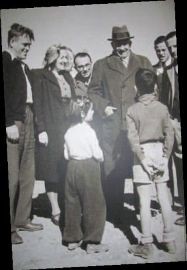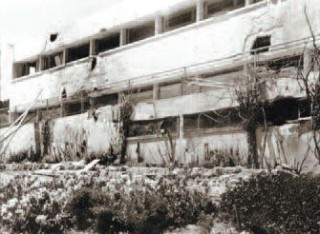A Boy and the Future President
Standing with his back to the camera, hands behind him with fingers clasping each other, one can almost feel the nervousness emanating from a six-year old kibbutz born boy reciting his well rehearsed greetings to a very important person visiting his community in 1939. Wearing dusty and extremely scuffed shoes, socks folded down over the top, khaki shorts and dark cotton shirt, the boy stood straight and proud as he greeted the V.I.P. who was none other than Zionist movement leader Chaim Weizmann, destined to become the first President of Israel (1949-1952),,who was paying an official visit to the boy's kibbutz, Mishmar HaEmek (founded in 1922), in the Jezreel Valley.
The black and white photo shows Yaacov Hazan standing alongside the future president of Israel. One of the founders of the kibbutz in 1922 (together with the boy's parents), Hazan was an extremely charismatic leader who was also a co-founder of the Hashomer Hatzair movement and served in the Israeli Knesset from 1949 to 1973. Arieh Diamond, another of the founder members and then leader of the community, is seen peering over Weizmann's shoulder at the nervous boy standing in front of them together with Tzipporah Bentov, whose husband and also a founder member of the kibbutz, Mordechai Bentov, was one of the signatories of the 1948 Declaration of Independence and a one-time government minister.
"I was literally quaking in my shoes standing in front of them," said 81 year-old Ehud Lior, the boy in the 1939 photograph as he reminisced, holding a copy of the photo in one hand and spreading other sepia photos from the same visit across the dining table in his current spacious kibbutz abode. "I remember the day Emma Talmi came to my children's house and told me that Chaim Weizmann was coming to visit and that they wanted me to to welcome him on behalf of the kibbutz. I have absolutely no idea why they chose me out of the 60 children in the children's houses at that time," said Ehud who only recently retired from working in the kibbutz industry as well as being responsible for pest and rodent control for his collective community.
"In the beginning, I told Emma I didn't want to do it; that there were other children who would be better at learning and reciting a text than me. That definitely was not something I was good at. However, in the end I agreed and I sat with Emma every day for two weeks working on the text that she had written. She was a real perfectionist," he explained. A four-year old girl, Nurit, was chosen to present flowers to Weizmann's wife, Vera, at the same ceremony and the two children also rehearsed the order of things for the special day.
"A new kibbutz dining-room was being constructed and all the kibbutz members gathered there to greet the Weizmanns. There were about 300 adults and children as it really was a very special occasion. I stepped forward to begin my part and suddenly realized that his wife wasn't there. Apparently she was sick and nobody had been told that she wasn't going to attend, so I had to really think on my feet. I somehow managed to change my speech to just speak directly to him and not include his wife, as I had rehearsed for two weeks. "Nurit was standing there by my side with a bunch of violets and she honestly didn't know what to do, so I pushed her toward Tzippora Bentov and she presented her with the bouquet instead. All I really remember is shaking all over when it was finished, and thank goodness I was never asked to do something like that again," he said. He also commented that Chaim Weizmann was already suffering from severe loss of sight and Ehud doubted if he had noticed Nurit giving the flowers to Tzippora Bentov anyway.
In 1948 Ehud was a teenager living, studying and working in the Shomria high school – a boarding school for all the children from Hashomer Hatzair kibbutzim throughout the country, the first of its kind and situated in Mishmar HaEmek. "My peers and I lived in the building that was known as the 'big house', a three storey building containing dorms, showers and classrooms. We were two groups living in the building, 24 in each group, 4 to a bedroom with boys and girls sharing. The rooms were really small and the beds were just boards with thin mattresses and were attached to the wall. During the day, they were folded to the wall and that created at least some space for movement."
On April 4, 1948 at 17.30, mortars were fired on the kibbutz from the surrounding hills where a 1,000-strong contingent of the Arab Liberation Army under commander Fawzi al-Kauwji attacked the kibbutz situated on the slopes of the Menashe Hills. He was intent on taking the highly strategic kibbutz which hugged the main Haifa to Jenin road and was just a few kilometers from the ancient tel of Megiddo and an all important major junction, and after his victory, to continue and conquer Haifa.
After a fierce battle lasting 10 days, with heavy losses of lives and damage to kibbutz property, al-Kauwji and his men were defeated and forced out of the area.
"The morning that the attack began, we had been preparing a wooden wall on the outside of our building and filling it with gravel. We were told this would protect us and that nothing would happen as they didn't have a cannon, which, of course, proved to be incorrect. The group on the floor above us came down to our rooms and we all covered ourselves with the mattresses. After a while there was a terrible explosion and we were all covered in plaster that had come loose from the walls, and because of the thick dust we couldn't see anything. I had felt something go over my leg when I was on the floor but had no idea what it was,but because of the explosion I yelled as loud as I could that a bomb had landed in our room although I couldn't see anything because of the dust. We left our room, went to the one next door and crawled under the mattresses together with the people who were already under them. We stayed all night in the neighboring room under those mattresses. One of the girls wanted to pee but was afraid to leave the room. However, eventually she and another girl did. When they came back, having picked their way through all the debris they told us that there was an unexploded bomb sitting in the middle of our room and then I knew what had passed over my leg," said Ehud with a grimace.
During the second night of the devastating attack on Mishmar HaEmek, one of the women educators led the children, carrying their blankets and crawling on all fours, toward the forest behind the kibbutz to a large cave known as the Palmach Cave.
"I remember crawling and then running, clutching my blanket. We were pretty scared," said Ehud. All the children made the dangerous run safely but the educator, who stopped to protect some of the children who came under fire, was badly wounded and unfortunately lost one of her legs as a result of her injuries.
During a ceasefire brokered by the British, the children were evacuated from Mishmar HaEmek to Kibbutz Mizra on the other side of the valley. Ehud remembers being taken by British soldiers to Mizra where they stayed for a few months. There are letters in the kibbutz archives penned by the children to their parents, full of longing to be able to return home to their corner of the valley so near yet so far away.










Comments